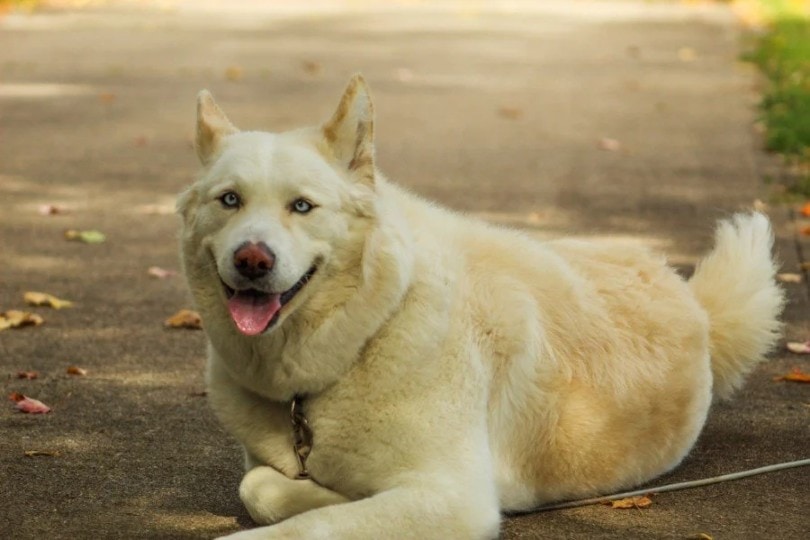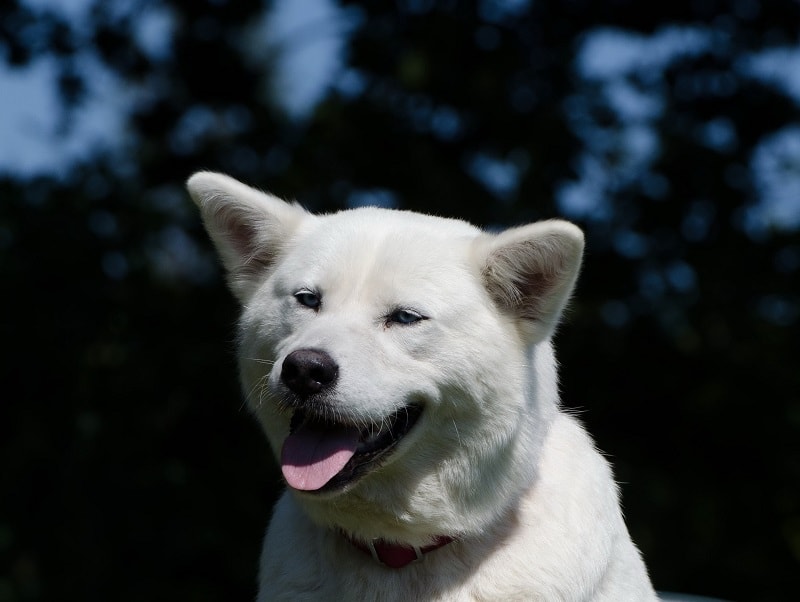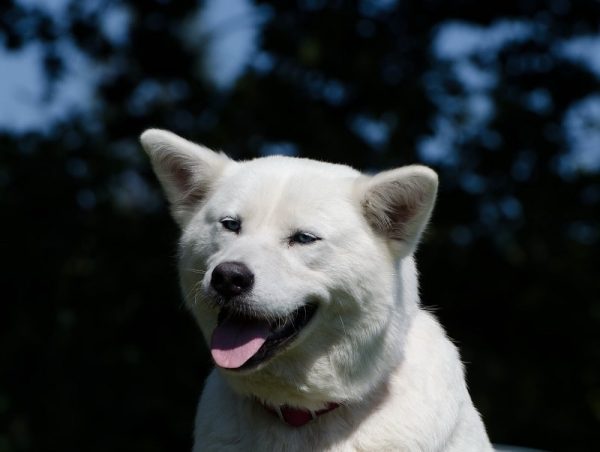Click Below to Skip Ahead
With the rise in popularity of designer breeds, it’s no wonder the Huskita has become such a popular breed. A mix between the Siberian Husky and the Akita, these large and adorable pups are a great fit for many families.
Breed Overview
Height:
22 – 25 inches
Weight:
50 – 75 pounds
Lifespan:
10 – 13 years
Colors:
White, black and cream, or tan
Suitable for:
Active families, first-time dog owners, and those with large fenced-in yards
Temperament:
Independent, intelligent, stubborn, energetic, active, loyal, and protective
They’re a little stubborn, but their independent streak is one of their main selling points, as is their incredible loyalty and protectiveness. But while these pups are cute and adorable, they’re certainly not for everyone.
Not only are they notoriously stubborn, but they can also be a bit tricky to socialize, though it’s not impossible. So, is a Huskita right for you and your family? We break down everything that you need to know about these high-energy dogs here!
Huskita Puppies
While the Huskita is not a purebred puppy, the truth is that they are highly sought-after and can therefore end up being more expensive than you may expect.
This independent and loyal breed is a good fog for a first-time dog owner. They are energetic so it would be beneficial if you have a large fenced-in yard.

Temperament & Intelligence of the Huskita
There’s little doubt that the Huskita is an extremely intelligent breed. Both the Siberian Husky and the Akita are smart dogs, so it doesn’t matter which parent breed that they take after! Both the Akita and the Husky are a bit stubborn, so your pup will inherit that trait too.
They’re extremely active, protective, and loyal, so if you’re looking for a family guard dog, the Huskita is an excellent choice. However, they’re not as playful as some other breeds, especially with other dogs or pets.
While the Huskita is a high-energy dog, they have a fierce independent streak. While they still need attention from their owners, they don’t need that much. Their mostly laid-back demeanor (as long as they’re getting enough exercise) makes them an excellent choice for first-time dog owners.
Are These Dogs Good for Families?
While the Huskita can be a great family dog, they need extra socialization to ensure that they’re a good fit. But once you get past the initial introductory period, your Huskita will be an extremely loyal and protective dog, which is why so many people with children love them.
Their larger size also means that falling toddlers and kids are less likely to hurt them, but you should always supervise interactions between dogs and small children.
Also, keep in mind that Huskita has a shorter lifespan than many smaller dogs, which can be hard for both children and adults as they age.
Does This Breed Get Along With Other Pets?
While you can socialize a Huskita to get along with other pets, it’s not something that comes naturally to them. They tend to be particularly aggressive to smaller animals, so small dogs and cats can be a no-go.
If you take the time to socialize a Huskita when they’re young, you can mitigate and potentially eliminate these concerns. But be especially wary when introducing a smaller animal to an older Huskita.
Take it slow, and give your Huskita plenty of time to adjust. Keep in mind that without tons of socialization and patience, your Huskita might never tolerate other animals. If you have a multi-pet household, a Huskita might not be the best fit.
Things to Know When Owning a Huskita
While the Huskita might make an excellent pup for first-time dog owners, that doesn’t mean there aren’t things that you need to be aware of before purchasing one. We highlighted a few of their basic care requirements here.
Food & Diet Requirements
The Huskita is a bigger dog, and thus, it eats more than other pups. A 50-pound Huskita needs about 3 cups of food each day, while a larger 75-pound Huskita needs closer to 4.5 cups each day.
But no matter the size of your dog, you need to choose a high-quality dry kibble that doesn’t have a bunch of fillers. While these foods might be more expensive than the low-quality stuff, they will give your dog all the nutrients that they need and keep them happier and healthier.
Exercise
The Huskita is a high-energy dog, and due to their larger size, they won’t be able to meet their exercise requirements in the house. While you can take them on plenty of walks, the only way that you can meet all their exercise requirements is with a large fenced-in yard.
This will give them plenty of room to run and roam, which is hard to do with daily walks alone. However, having a fenced-in yard isn’t a substitute for walks. Unless you live out on a ranch with tons of space for your dog to roam, you’ll still need to take them out a few times a day.
Aim for 10–14 miles a week, but chances are that your Huskita will always appreciate more walking time.
Training
While the Huskita often gets a bad rap as an untrainable dog, the truth is that once you break through their stubborn streak, training them is easier than you might think. The key is consistency and positive reinforcement.
If it turns into a battle of wills between you and Huskita, it’s a fight that neither of you will enjoy having. But if you can convince your Huskita that they want to do what you’re telling them to do, everything will go smoother.
This is where positive reinforcement is crucial. The Huskita loves attention and treats, and if they enjoy the reward, they’ll want to do whatever you’re asking of them. Once they’ve become accustomed to the task, you can wean them off the treats and still get the same results.
Just don’t expect results overnight when you’re training a Huskita. But keep in mind that due to their high intelligence, there are few tasks that you can’t train them to do.
Grooming ✂️
Keeping up with the necessary grooming requirements for a Huskita requires a bit of work. They have an extremely thick coat, even if it isn’t that long. You’ll need to brush the coat out at least once a week, but daily brushing is best to stay on top of things.
In addition to keeping up with their coat, you should bathe them about once a month to keep their coat healthy. Furthermore, you need to brush their teeth a few times a week to maintain good oral hygiene.

Health and Conditions
While many crossbreeds are known to have fewer health concerns than their parent breeds, the truth is that it all comes down to a genetic lottery. They will pull half their genetics from each parent breed, which means they can inherit conditions from both breeds.
The best way to keep your Akita healthy is to meet all their daily activity requirements while feeding them a healthy diet. The Huskita is a relatively healthy breed, although there are a few concerns that you should keep an eye out for.
If you notice any of the following conditions, you should seek out veterinary care right away.
- Ear infections
- Obesity
- Dental problems
- Zinc-responsive dermatosis
- Dysplasia
- Epilepsy
- Hemophilia
- Progressive retinal atrophy
Male vs. Female
While there aren’t many differences between a male and female Huskita, there are two that you should be aware of. First, while the majority of their size difference comes from the parent breed that they take after, males do tend to be a bit larger than females.
That means if you want a 75-pound Huskita, you should opt for a male. While this is no guarantee of size, it does increase the chances that you’ll get a larger dog.
Second, males tend to need more attention from their owners than females. While female Huskitas will undoubtedly need plenty of attention from their owner, males typically need more. However, keep in mind that this depends in large part on your particular dog’s temperament and personality.
Some female dogs are extremely needy, while some males are a bit more aloof. But typically, males require more attention and guidance.
3 Little-Known Facts About the Huskita
1. You Need to Keep the Huskita Busy
While the Huskita is a more independent pooch, that doesn’t mean they can figure everything out for themselves. You need to spend time with them and keep them busy. Work tasks are ideal for the Huskita because these get them involved without you needing to watch them every second.
2. The Huskita Is Extremely Trainable — But Stubborn
Training the Huskita takes work. But once you get past their stubborn streak, these dogs are highly trainable and aim to please; you just need to convince them that it’s what they want to do. Stick with the training, and you’ll have a great dog that follows commands.
3. Socializing a Huskita Can Be Challenging
Some dogs simply love being around other animals, but the Huskita isn’t one of them. They prefer to be solitary dogs, so you might run into problems if you have many pups around. If you socialize a Huskita early, they can overcome these challenges, but for many Huskitas, it’s going to take time.
Final Thoughts
If you’re looking for a large dog that doesn’t need your attention every second of every day, the Huskita might be a great choice. They’re incredibly loyal and protective, making them excellent guard dogs for you and your family.
However, ensure that you have plenty of space for them to roam because they are high-energy. If you don’t get them the exercise that they need, all their perks will quickly get wiped out as they destroy your house out of boredom!
Related Read:
- Cane Corso Akita Mix: Guide, Pictures, Care & More
- Pakita (Akita Great Pyrenees Mix): Pictures, Guide, Info, & Care
Featured Image Credit: 825545, Pixabay








